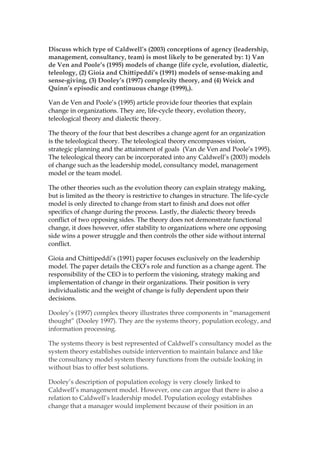
Conceptions of agency - CM 4
- 1. © SMART Leadership Consulting a SMART way of doing business May 28, 2014 Daryl Horney SMART Leadership Consulting Discuss which type of Caldwell’s (2003) conceptions of agency (leadership, management, consultancy, team) is most likely to be generated by: 1) Van de Ven and Poole’s (1995) models of change (life cycle, evolution, dialectic, teleology, (2) Gioia and Chittipeddi’s (1991) models of sense-making and sense-giving, (3) Dooley’s (1997) complexity theory, and (4) Weick and Quinn’s episodic and continuous change (1999),). Van de Ven and Poole’s (1995) article provide four theories that explain change in organizations. They are, life-cycle theory, evolution theory, teleological theory and dialectic theory. The theory of the four that best describes a change agent for an organization is the teleological theory. The teleological theory encompasses vision, strategic planning and the attainment of goals (Van de Ven and Poole’s 1995). The teleological theory can be incorporated into any Caldwell’s (2003) models of change such as the leadership model, consultancy model, management model or the team model. The other theories such as the evolution theory can explain strategy making, but is limited as the theory is restrictive to changes in structure. The life-cycle model is only directed to change from start to finish and does not offer specifics of change during the process. Lastly, the dialectic theory breeds conflict of two opposing sides. The theory does not demonstrate functional change, it does however, offer stability to organizations where one opposing
- 2. side wins a power struggle and then controls the other side without internal conflict. Gioia and Chittipeddi’s (1991) paper focuses exclusively on the leadership model. The paper details the CEO’s role and function as a change agent. The responsibility of the CEO is to perform the visioning, strategy making and implementation of change in their organizations. Their position is very individualistic and the weight of change is fully dependent upon their decisions. Dooley’s (1997) complex theory illustrates three components in “management thought” (Dooley 1997). They are the systems theory, population ecology, and information processing. The systems theory is best represented of Caldwell’s consultancy model as the system theory establishes outside intervention to maintain balance and like the consultancy model system theory functions from the outside looking in without bias to offer best solutions. Dooley’s description of population ecology is very closely linked to Caldwell’s management model. However, one can argue that there is also a relation to Caldwell’s leadership model. Population ecology establishes change that a manager would implement because of their position in an organization. Both population ecology and the management model view traditional traits of change and both value the need for individual infusion of decision-making and innovation (Dooley 1997). Dooley’s analysis of information processing provides the best representation of Caldwell’s team model. Information processing is cognitive in organizational learning. The dynamics of information processing encompass the gaining of knowledge and involve adapting this knowledge. The learning from this knowledge is used to provide individuals with the know how to become and perform as change agents. These individuals can be paired into subgroups thus creating the essence of Caldwell’s team model (Dooley 1997). Weick and Quinn’s (1999) paper provide two agents of change, episodic change and continuous change. The consultancy model best represents episodic change. As Weick and Quinn, state episodic change is “relevant when it is necessary to create change.” One of the five assumptions (Marchak, 1993 cited in Weick and Quinn 1999) is the separateness assumption. The separateness assumption is understood by providing an outside influence. Consultant change agents accomplish this outside influence in organizations. The leadership model best represents Weick and Quinn’s (1999) analysis of continuous change. The authors clearly state organization change takes place because the leader is the model of change. Continuous change is provided by
- 3. a leader who personally changes in behavior in order to direct change in an organization (Weick and Quinn 1999). Which model gives the most agency to employees and which gives the least? Why? Caldwell (2003) offers four models of change agents. Each change agent model exhibits dynamics that offers the best options for organizations to elect from. However, some of the models offer more participation from employees while others do not. The change agent model that gives the most agency to employees is the team model. The team model allows members of an organization on all levels to be representatives of change. Employees from various divisions with different responsibilities can join together to discuss what changes need to be implemented. However, Caldwell did not say whether the team recommendations of change is actually carried out by themselves or whether their recommendations have to go through a final review by the decision makers of the organization (Caldwell 2003). The change agent model that offers the least agency to employees would be the leadership model. The leadership model demonstrated by Caldwell (2003) only allows for one person or a small group of select persons in top management to be the representative of change. Their position adapts a hierarchal formation where he/she decides what is best for the organization and delivers it down to lower management. Employees do not have a choice in respect to change thus, not allowing for representation. Reference Caldwell, R. (2003) ‘Models of change agency: A fourfold classification’, British Journal of Management, 14 (2), pp.131–142. Available from: http://sfxhosted.exlibrisgroup.com.ezproxy.liv.ac.uk/lpu?title=British+Journal+of+M anagement&volume=14&issue=2&spage=131&date=2003 Dooley K.J. (1997) ‘A complex adaptive systems model of organizational change’, Nonlinear Dynamics, Psychology, and Life Science, 1 (1), pp.69–97. Available from:http://search.ebscohost.com.ezproxy.liv.ac.uk/login.aspx?direct=true&db=ecn&AN=0 582857&site=eds-live Gioia, D.A., & Chittipeddi, K. (1991) ‘Sensemaking and sensegiving in strategic change initiation’,Strategic Management Journal, 12 (6), pp.433–448. Available from: http://sfxhosted.exlibrisgroup.com.ezproxy.liv.ac.uk/lpu?title=Strategic+Management+Jour nal&volume=12&issue=6&spage=433&date=1991 Van de Ven, A.H. & M.S. Poole (1995) ‘Explaining development and change in organizations’, Academy of Management Review, 20 (3), pp.510–540. Available from: http://sfxhosted.exlibrisgroup.com.ezproxy.liv.ac.uk/lpu?title=Academy+of+Management+ Review&volume=20&issue=3&spage=510&date=1995
- 4. Weick, K.E., & Quinn, R.E. (1999) ‘Organizational change and development’, Annual Review of Psychology, 50, pp.361–386. Available from: http://sfxhosted.exlibrisgroup.com.ezproxy.liv.ac.uk/lpu?title=Annual+Review+of+P sychology&volume=50&issue=&spage=361&date=1999
